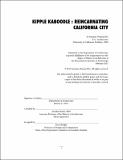| dc.contributor.advisor | Arindam Dutta. | en_US |
| dc.contributor.author | Pho, Susanna Wansan | en_US |
| dc.contributor.other | Massachusetts Institute of Technology. Department of Architecture. | en_US |
| dc.coverage.spatial | n-us-ca | en_US |
| dc.date.accessioned | 2015-06-10T18:41:45Z | |
| dc.date.available | 2015-06-10T18:41:45Z | |
| dc.date.copyright | 2015 | en_US |
| dc.date.issued | 2015 | en_US |
| dc.identifier.uri | http://hdl.handle.net/1721.1/97270 | |
| dc.description | Thesis: M. Arch., Massachusetts Institute of Technology, Department of Architecture, 2015. | en_US |
| dc.description | This electronic version was submitted by the student author. The certified thesis is available in the Institute Archives and Special Collections. | en_US |
| dc.description | Cataloged from student-submitted PDF version of thesis. | en_US |
| dc.description | Includes bibliographical references (page 106). | en_US |
| dc.description.abstract | California City is a superlative shrinking suburb. Situated deep in the Mojave Desert, the conditions that typically spur suburban shrinkage are exaggerated here. As such, the city provides a singular opportunity to comment on the decline of the road-centric, single family house dominated town typology within a specific context. This thesis examines the decaying suburban condition and proposes an architectural intervention that embraces a city's collapse as analogous to death and imagines a reincarnated future. It addresses the notion that shrinkage must be either reversed or ameliorated and instead proposes that it be amplified and radicalized. The architectural proposal is activated at two scales: that of the landscape (or kaboodle) and that of the individual belonging (or kipple). As the town grapples with death on a suburban scale, it encounters deeply personal questions as an entire community. What does it mean when a city dies? How do those who must remain grieve, come to terms with their loss, and move on? What becomes of the corpse? The stuff of the suburb is examined in depth as the psyche of California City and given architectural agency as the means by which the town is destroyed, reconstituted and rebirthed anew. As it is abandoned, salvaged, catalogued, and transformed, this suburban discharge slowly transforms the reincarnated city into an archival catalog of a previous being: an enclavic representation of what was lost. | en_US |
| dc.description.statementofresponsibility | by Susanna Wansan Pho. | en_US |
| dc.format.extent | 107 pages | en_US |
| dc.language.iso | eng | en_US |
| dc.publisher | Massachusetts Institute of Technology | en_US |
| dc.rights | M.I.T. theses are protected by copyright. They may be viewed from this source for any purpose, but reproduction or distribution in any format is prohibited without written permission. See provided URL for inquiries about permission. | en_US |
| dc.rights.uri | http://dspace.mit.edu/handle/1721.1/7582 | en_US |
| dc.subject | Architecture. | en_US |
| dc.title | Kipple kaboodle : reincarnating California city | en_US |
| dc.title.alternative | Reincarnating California city | en_US |
| dc.type | Thesis | en_US |
| dc.description.degree | M. Arch. | en_US |
| dc.contributor.department | Massachusetts Institute of Technology. Department of Architecture | |
| dc.identifier.oclc | 910673303 | en_US |
